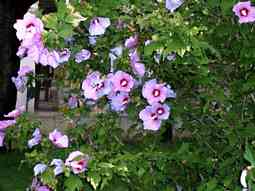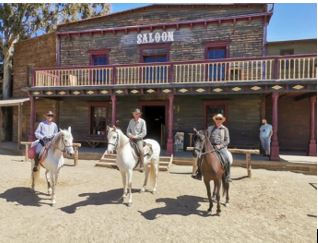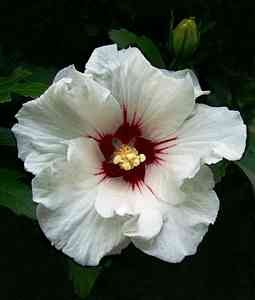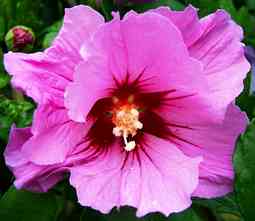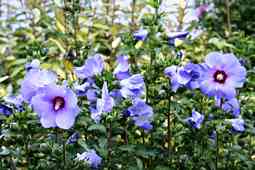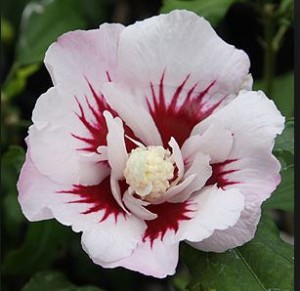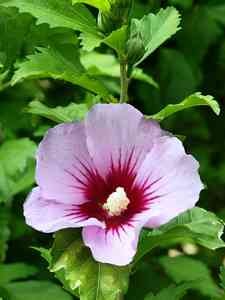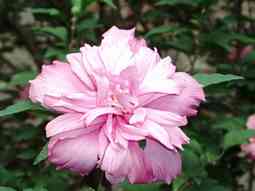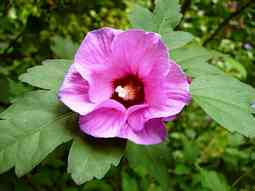Hibiscus syriacus, also called Rose of Sharon Althea or Hardy Hibiscus
Hibiscus syriacus is a deciduous, flowering shrub with large showy flowers (in single or double flowering form, with solid colours or bicolours) that blooms all summer long.
This woody perennial is native to India and East Asia and not, as Linnaeus thought, to Syria, in spite of the name he gave it.
As for the common name ‘Rose of Sharon’, the plant should not to be mistaken for Hypericum calycinum (also known as St John’s Wort), which in the UK and Australia is sometimes also called Rose of Sharon.
Unlike our common Tropical Hibiscus (Hibiscus rosa-sinensis), Hibiscus syriacus will help bring a bit of tropical beauty to more temperate climates.
It is hardy to about -20° C (-4° F) when mature, but when planted in colder areas, it will need protection for the first few winters – be sure to mulch well.
Horse Riding Holidays in Province of Almeria
A selection of Horse Riding Holidays in the Almeria Area TAKE YOUR PICK
Hibiscus syriacus
Although hardy, Rose of Sharon actually prefers heat and will bloom better with hot summers.
hibiscos-bush
Hibiscos flower
Flowers/Fruit/Foliage of Rose of Sharon:
Rose of Sharon is widely planted for its large and very attractive five-petal flowers
in shades of white, pink, red, lavender, or purple – often with a different spot of colour in the middle of the throat.
The flowers can be single or double and appear from midsummer to early autumn on current season’s growth.
Individual flowers are short-lived, lasting only a day, however, numerous flower buds are produced which provides prolific flowering over a long period.
Hibiscus syriacus Hermaphrodite
The flowers are hermaphrodite (have both male and female organs) and are pollinated by insects attracted by flat blossoms and nectar.
The fruit are seed-capsules and Rose of Sharon can be very invasive due to the numerous seeds produced in the capsules.
Snip them off before they open, or choose one of the newer cultivars that are genetic hybrids – the triploids.
These produce few (if any) seed capsules.
Hibiscos pink flower
Hibiscus bush blueThe leaves of the shrub are medium to dark green, 2-4″ (5-10 cm) long, often with 3 lobes, and jagged edges.
Don’t be surprised if the leaves arrive after most of your other plants. Its leaves usually start to show around the end of spring or early summer, causing false alarms in gardeners who think their plants may have died.
The leaves hold late into autumn before turning a yellowish green.
How to Divide & Transplant a Hibiscus : Gardening Tips.
Hibiscus are some of the most beautiful flowering shrubs in the tropical garden.
Divide and transplant a hibiscus with help from a certified professional horticulturist through the American Society for Horticultural Science in this free video clip.
Expert: Justin Hancock
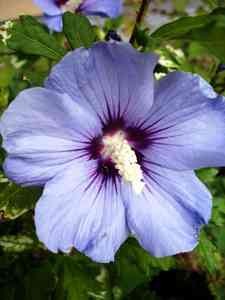 Hibiscus syriacus Growing tips:
Hibiscus syriacus Growing tips:
To give the best growing conditions to your Hibiscus, plant it in a place with full sun as it likes hot weather.
It will also tolerate partial shade. Rose of Sharon grows best in moist, well drained soil that contains lots of organic matter, though happily it is able to tolerate a wide variety of soils.
It is an easy to grow plant because of its relatively rapid establishment and can be easily transplanted without being disturbed too much. When it is newly planted be sure to water every few days until established.
When mature, Rose of Sharon is somewhat tolerant of drought conditions, but the buds may drop if the plant is watered too much or too little, or if too much fertilizer is applied.
Rose of Sharon
Rose of Sharon white
Hibiscus syriacus Maintenance/Pruning:
Rose of Sharon has a medium growth rate. Branching begins near the ground with numerous vertical branches.
The natural growth pattern for the shrub is upright with spreading branches that develop into a vase-shaped profile.
It can reach up to13 feet (4 m) in height.
If not pruned, the limbs tend to arch away from the center as the plant ages.
Though it is naturally a multi-stemmed shrub, the lower limbs are sometimes removed to present the shrub in tree form.
It can also be trained as an espalier or shaped into a hedge.
Since plants bloom on new growth, shaping or pruning can be done at any time.
Hibiscus syriacus Pruning
Prune as needed to maintain the shape desired. In winter or early spring, last season’s growth should be pruned away, which will help produce bigger blooms (In northern climates, prune only in late winter or early spring to avoid frost damage).
Rose of Sharon pinky
HibiscusUses:
Rose of Sharon is the perfect shrub for groupings and mass plantings, to create a screen, or planted as a formal or informal hedge or in a shrub border.
Standard forms may be used as small trees or next to entrance ways.
Be careful when using this as a specimen plant – remember that the leaves appear late in spring and the blooms do not show until later in summer.
Though prized for its profuse blooming throughout the summer, the shrub is less ornamentally attractive in late autumn.
Propagation:
Hibiscus syriacus is fairly easily propagated from either seeds, with variable results, or by layering or cuttings, cloning the original.
Though it has little winter interest and can be stiff and ungainly if badly pruned, Rose of Sharon remains a popular ornamental shrub with many cultivars.
It is a beautiful and delightful shrub that will give you years of charming flowers just when you need them in the late summer and autumn.
Rose of Sharon Double
Hibiscus Hibiscus syriacus, also called ‘Rose of Sharon’, ‘Althea’, or ‘Hardy Hibiscus’ is a deciduous, flowering shrub with large showy flowers (in single or double flowering form, with solid colours or bicolours) that blooms all summer long.
Marc Vijverberg
Stem Cuttings Of Tropical Hibiscus.
Hibiscus syriacus
Growing Hibiscus is a passion for creation, and it makes you feel you are doing magic. I can hear the “Wwooowws” from many hibiscus friends worldwide whenever one of us has bred a stunning seedling with unique pattern and color combination.
Hibiscus syriacus, also called ‘Rose of Sharon’, ‘Althea’, or ‘Hardy Hibiscus’ is a deciduous, flowering shrub with large showy flowers (in single or double flowering form, wi
8,36,20 rich. Hibiscus syriacus Optimised P 90 w 100 March 8 July 10 h 51 Jan 11 Hibiscus Syriacus 13 H 90
Spain Info.
San Francisco De Asis, Urb Marina, San Fulgencio, 03177, Alicante, Spain
38n21, 0w29.
Site Disclaimer
Disclaimer: Whilst every effort has been made to provide accurate information, no liability will be accepted for misinterpretation, misrepresentation, errors or omissions - the information provided by our Websites is for use as a guide only and is issued in good faith as information..
All photographs images and FILM material is subject to the understanding that as they are in the public domain they can be used and shared as seen to be appropriate and unless showing a sign that they are covered by copyright law. This also covers Social media operations.
1999---2026

